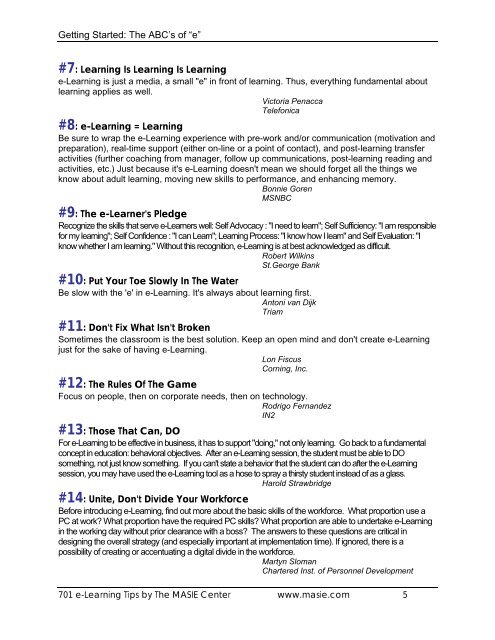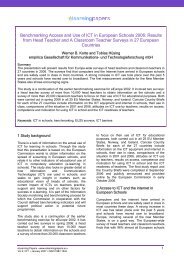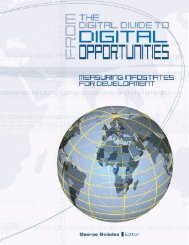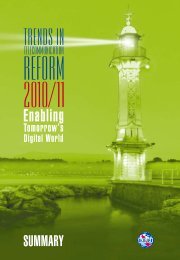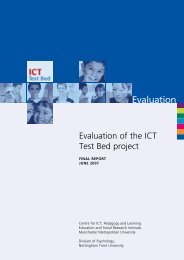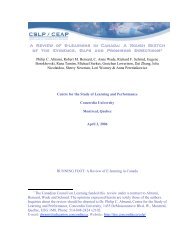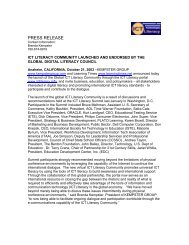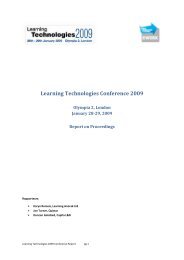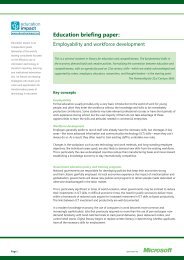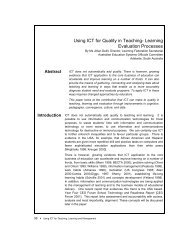147 pages pdf - ICT Digital Literacy
147 pages pdf - ICT Digital Literacy
147 pages pdf - ICT Digital Literacy
Create successful ePaper yourself
Turn your PDF publications into a flip-book with our unique Google optimized e-Paper software.
Getting Started: The ABC’s of “e”<br />
#7: Learning Is Learning Is Learning<br />
e-Learning is just a media, a small "e" in front of learning. Thus, everything fundamental about<br />
learning applies as well.<br />
Victoria Penacca<br />
Telefonica<br />
#8: e-Learning = Learning<br />
Be sure to wrap the e-Learning experience with pre-work and/or communication (motivation and<br />
preparation), real-time support (either on-line or a point of contact), and post-learning transfer<br />
activities (further coaching from manager, follow up communications, post-learning reading and<br />
activities, etc.) Just because it's e-Learning doesn't mean we should forget all the things we<br />
know about adult learning, moving new skills to performance, and enhancing memory.<br />
Bonnie Goren<br />
MSNBC<br />
#9: The e-Learner's Pledge<br />
Recognize the skills that serve e-Learners well: Self Advocacy : "I need to learn"; Self Sufficiency: "I am responsible<br />
for my learning"; Self Confidence : "I can Learn"; Learning Process: "I know how I learn" and Self Evaluation: "I<br />
know whether I am learning." Without this recognition, e-Learning is at best acknowledged as difficult.<br />
Robert Wilkins<br />
St.George Bank<br />
#10: Put Your Toe Slowly In The Water<br />
Be slow with the 'e' in e-Learning. It's always about learning first.<br />
Antoni van Dijk<br />
Triam<br />
#11: Don't Fix What Isn't Broken<br />
Sometimes the classroom is the best solution. Keep an open mind and don't create e-Learning<br />
just for the sake of having e-Learning.<br />
Lon Fiscus<br />
Corning, Inc.<br />
#12: The Rules Of The Game<br />
Focus on people, then on corporate needs, then on technology.<br />
Rodrigo Fernandez<br />
IN2<br />
#13: Those That Can, DO<br />
For e-Learning to be effective in business, it has to support "doing," not only learning. Go back to a fundamental<br />
concept in education: behavioral objectives. After an e-Learning session, the student must be able to DO<br />
something, not just know something. If you can't state a behavior that the student can do after the e-Learning<br />
session, you may have used the e-Learning tool as a hose to spray a thirsty student instead of as a glass.<br />
Harold Strawbridge<br />
#14: Unite, Don't Divide Your Workforce<br />
Before introducing e-Learning, find out more about the basic skills of the workforce. What proportion use a<br />
PC at work? What proportion have the required PC skills? What proportion are able to undertake e-Learning<br />
in the working day without prior clearance with a boss? The answers to these questions are critical in<br />
designing the overall strategy (and especially important at implementation time). If ignored, there is a<br />
possibility of creating or accentuating a digital divide in the workforce.<br />
Martyn Sloman<br />
Chartered Inst. of Personnel Development<br />
701 e-Learning Tips by The MASIE Center www.masie.com 5


